The latest in a series of interviews with artists who have a significant body of work that makes use of or responds to network culture and digital technologies.
Eleanor Ford: You describe your book List of Consonants (Bottlecap Press, 2015) as an ambient novella, built from text you self-plagiarized from your writing following your friend’s suicide, entries on social media/online forums, and what you’ve called “real” found texts. Did you see this process of mangling of your past-works, or perhaps past-selves, as a means of creating a new corpus that resembles a hypertextual exchange? Or, alternately, does it reform texts preserved and found on the internet towards an organic, perhaps more human, structure?
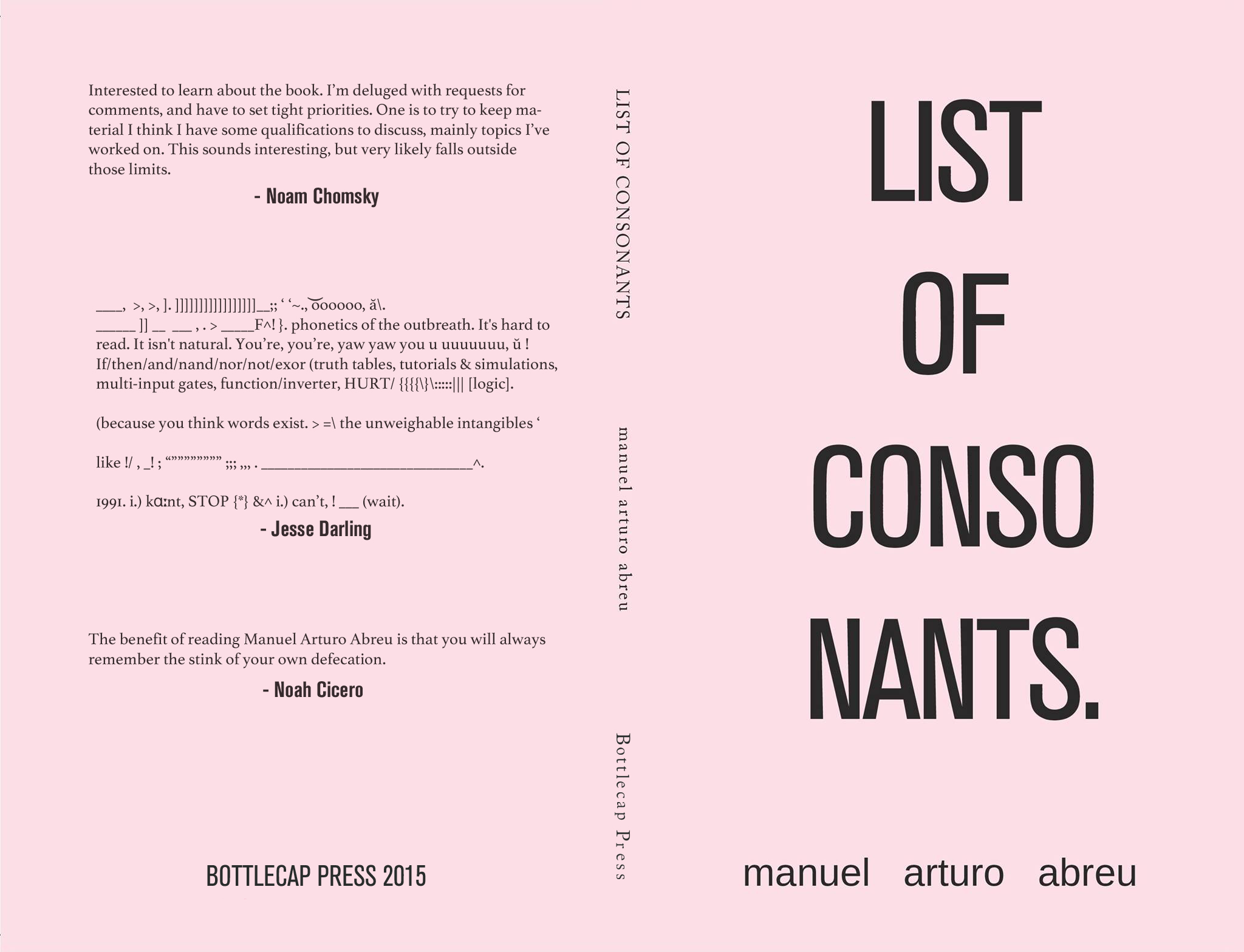
manuel arturo abreu, List of Consonants, Bottlecap Press (2015)
Manuel Arturo Abreu: After my friend passed I wrote tens of thousands of words in mourning-- very purple prose, selfish centering of my own feelings, mostly unusable. It felt good to write daily, so long and much, from scratch (for the past few years I’ve generally worked with found text). As such, I felt I needed to use that text somehow, maybe “sculpturally.” In the act of merging this from-scratch text with various kinds of found text, I was thinking about recycling, the commodification of trauma, and Wilson Harris’s notion of community-in-creator, which posits the self as a debt to the contexts and communities from which it emerges: “my voice” isn’t really my voice, it’s an assemblage, both vessel and vector for violence. I did partly feel a slippage between mourning my friend and trying to talk to him. I was also thinking of the peculiar guilt of losing someone and having it become a reason to keep going, but also a reason to talk over him, or through him, which seems bad, but necessary.
I wanted the text to complicate the commemorative, which is seen as the payment of respects but in fact incurs more debt to the dead, debt which is ultimately unpayable. I saw the process of forging the text as managerial: I generated the bulk of it in one sitting of about 60 hours. I wanted to set a trap for myself, not only through asking what the difference between from-scratch and found text is, but through the challenge of authentically performing the resulting texts (such as at poetry readings). In destabilizing the authoriality and authority of “my voice,” I tried to find a middle ground between the L=A=N=G=U=A=G=E dictum that confessionalism, indeed narrativity in general, is trite/apolitical, and the feminist dictum that the personal is political.
EF: The internet as a source for research came to a head in your online performance Servicio Digital a Papá Legba (2015), where your own “noob aesthetics” in the practice of Dominican Vudú were put on display to an online audience. Does this kind of provisional religious practice, in comparison to an individual raised in generational contact with the traditions of Vudú, perform a circum-generational reclamation of heritage? A neo-theological interpretation of the Vudú traditions that have made it onto the internet? Something else?
MAA: The trope of the researcher coming to gradually embody the object of analysis is so cheesy that I may regret divulging this, but my neophyte religious activity stemmed from research into an Afro-Cuban syncretic religion’s social media presence, which I presented at ACLA 2015. Its name was homophonous with an Afro-Dominican religious musical genre, which was my jumpoff. I am less interested in reclamation or authenticity, and more in the way that, as an Americanized immigrant, my relationship to island Dominican (vs. diasporic Dominican) cultures is heavily mediated, apart from my family, through consumer commodities, be it the internet, the people I talk to on it, or the content I engage on it.
I find myself with one foot in both the “displaced person” and “privileged Westerner” categories. The former denies me access to my provenance, while the latter affords me a certain level of protection. This renders my religion both provisional and provincial, but I think people come to their faiths in many ways, and the digital can act as a platform to encounter severed lineages and parallel timelines. As a performance, the piece was pretty much just me praying the way I would if I weren’t being recorded. However, as a simultaneous target of and vector for violence, I feel that making public my somewhat-makeshift beliefs was a way of engaging these issues: Does the mediated nature of my relationship to Dahomeyan-Haitian deities weaken my ability to petition them? Conversely, what role does the institutional platform play with respect to this mediation? I was also thinking about Sheilaism. 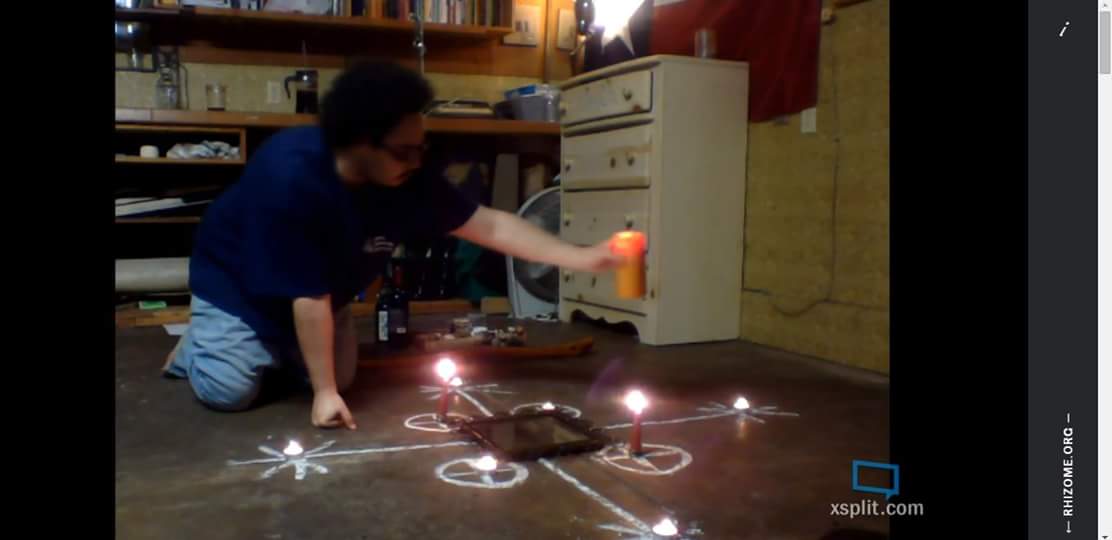
Screenshot from livestream of Servicio Digital a Papá Legba (2015) for First Look: Real Live Online co-hosted by Rhizome and the New Museum.
EF: You and Victoria Anne Reis (a BHQFU alum) started home school this year, a free pop-up art school in Portland that acts against the current MFA-obsessed culture of arts academe. Can you talk about the aims for the project long term, your personal experience teaching and how you’re deciding on instructors?
MAA: home school honors the etymology of “school,” from the Greek skholē, meaning leisure, rest, free time. I am interested in casual rigor, vernacular pedagogy, and the relationship between marginality and institutionality. Our curriculum consists of classes, talks, exhibitions, poetry readings, and more. We are currently in pop-up mode to investigate the relation between site and discursive texture, as well as to challenge ourselves in navigating Portland’s ephemeral project space scene, which, despite (or because of) its parochialism and precarity, enjoys a degree of regional and sometimes intra-national clout, even canonicity (Appendix Project Space and its aftermath is a good example). But we do hope to find a home at some point!
Victoria and I chose participants mostly nepotistically: my e-friends are pretty amazing. The first semester of 2016, which began in March, features two classes (one taught by me and one by Victoria), as well as remote talks by Hamishi Farah, Eunsong Kim (pictured here), Rosemary Kirton, Jesse Darling, and Jamondria Harris. The second semester features a class taught by you (Eleanor Ford), and a class taught by Portland performance troupe Physical Education (keyon gaskin, Allie Hankins, Lucy Lee Yim and Takahiro Yamamoto). We’ll also feature talks by Devin Kenny, damali ayo, Gaby Cepeda, Sonia Choi, Winslow Laroche, Sasha Puchalski, and Taj Bourgeois. I’m so excited!
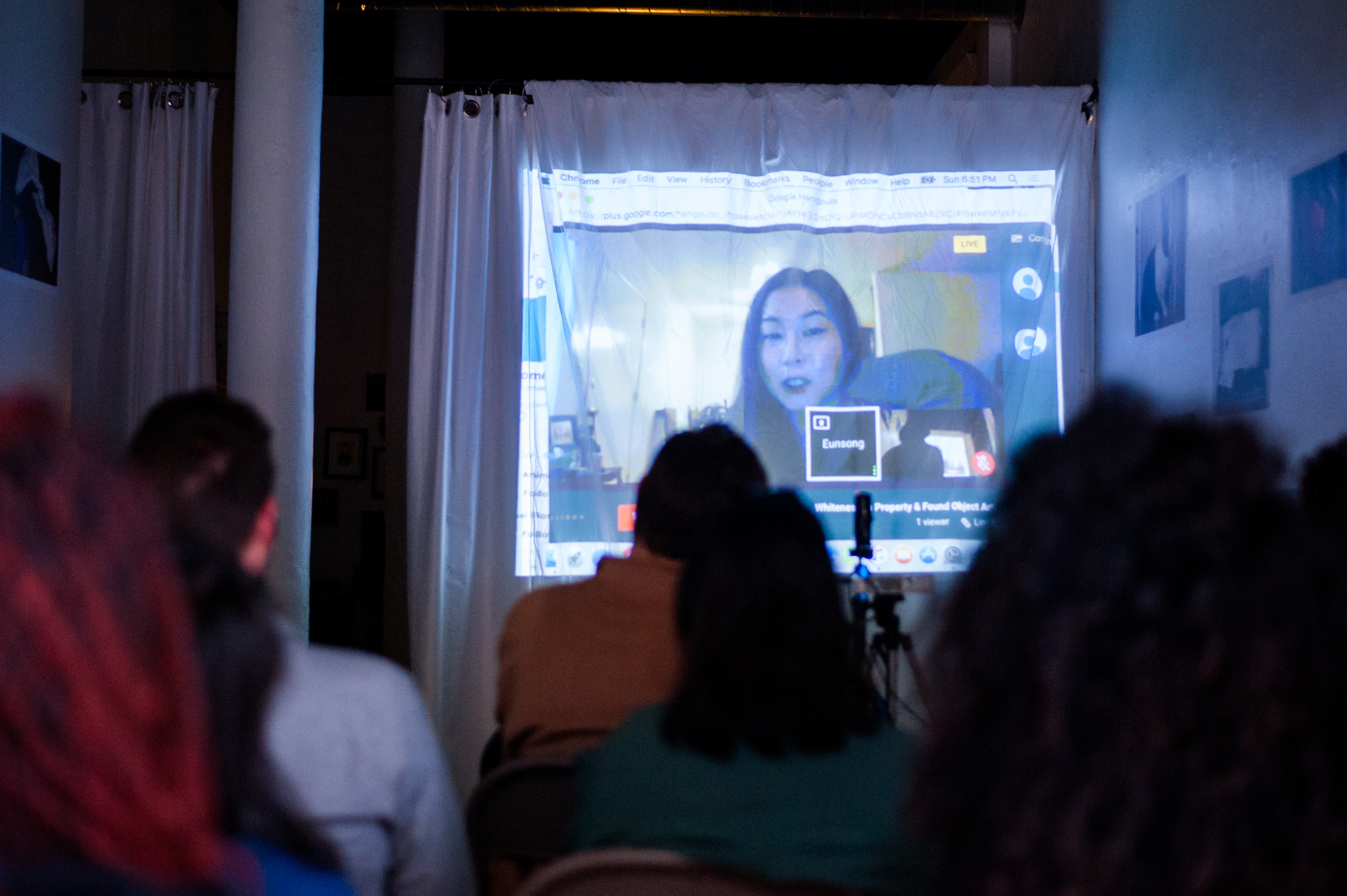
Eunsong Kim at Duplex for home school, Portland, OR, April 24, 2016
EF: Shifting gears a bit: a marketized art education seems like a yoke. From my non-MFA perspective, it seems like governance by debt: graduates accommodate market aesthetics in order to sell work, because otherwise the weight of the debt would destroy them. This seems like a big waste of time and an excuse to continue propping up white mediocrity, since the work itself is of less importance than the movement of capital and the continued precarization of art.
MAA: As an “alt arts edu” model, home school exists as a casual corrective not only to this marketization of education and aesthetics, but as a corrective to previous alt arts edu models: whether it’s a dearth of criticality or autonomy from the market, or a lack of distance learning opportunities, Victoria and I felt there was room for another method. The long-term goal is to build an archive showcasing the vernacular pedagogy and low-stakes, high-reward resource transfer that is so common to online friendships.
That being said, we owe a lot to those other models, so I want to name some names: BHQFU, Anton Vidokle’s Night School, Conceptual Oregon Performance School, University of Trash. As well, home school is lucky to be a 2015 Precipice Fund grantee; this allows us access to equipment, labor payment, and other necessities in order to be able to provide streams of every home school event.
EF: Your visual arts practice takes an ephemeral, non-art turn that I could see talked about as antagonistic to the idea of an art-object. Your day-to-day sculptural works are found “trash” that are re-collected, arranged and documented primarily through Instagram and your garageresidency Tumblr, which you began upon moving into a garage in Southeast Portland after a period of housing instability. How do you contextualize this process as art-making in the moment of creation and once the digital footprint is all that is left?

[artist unknown]
MAA: I want to say “I don’t contextualize it like that” but I’d be lying or something... First and foremost, I do it because I like it, regardless of whether context, discourse, and/or institutionality allow the labor to be legible as art.
Second, I want to be a cool art kid, but I’m not much of a maker. This means that regardless of my investment in reading certain aesthetic labors as art, at least to some extent what I do needs to be read this way for my contingent inclusion in ~ the Discourse ~. “Luckily,” this may actually be to my advantage: Paul Mann says in The Theory-Death of the Avant Garde that “the dematerialization of the art object is the refetishization of discourse.” The non-artistic nature of aspects of my practice speak, at least in part, to this situation, in which language’s power as value creator and impression management machine frame and validate aesthetic labor; I want my work to talk back to its framing, by its own dissolution or otherwise, not just mutely accommodate it. #goals
Third, when I moved into the garage around in 2013, I was thinking a lot about Brian Droitcour’s critique of post-internet objects, which he says don't activate space, instead preening themselves for the camera. He states this pejoratively, but it made me think about the slippage between an ephemeral work and its documentation: is activating space something that a work inherently needs to do? Can this activation happen digitally (this question assumed the internet as a space, not a process, but still)?
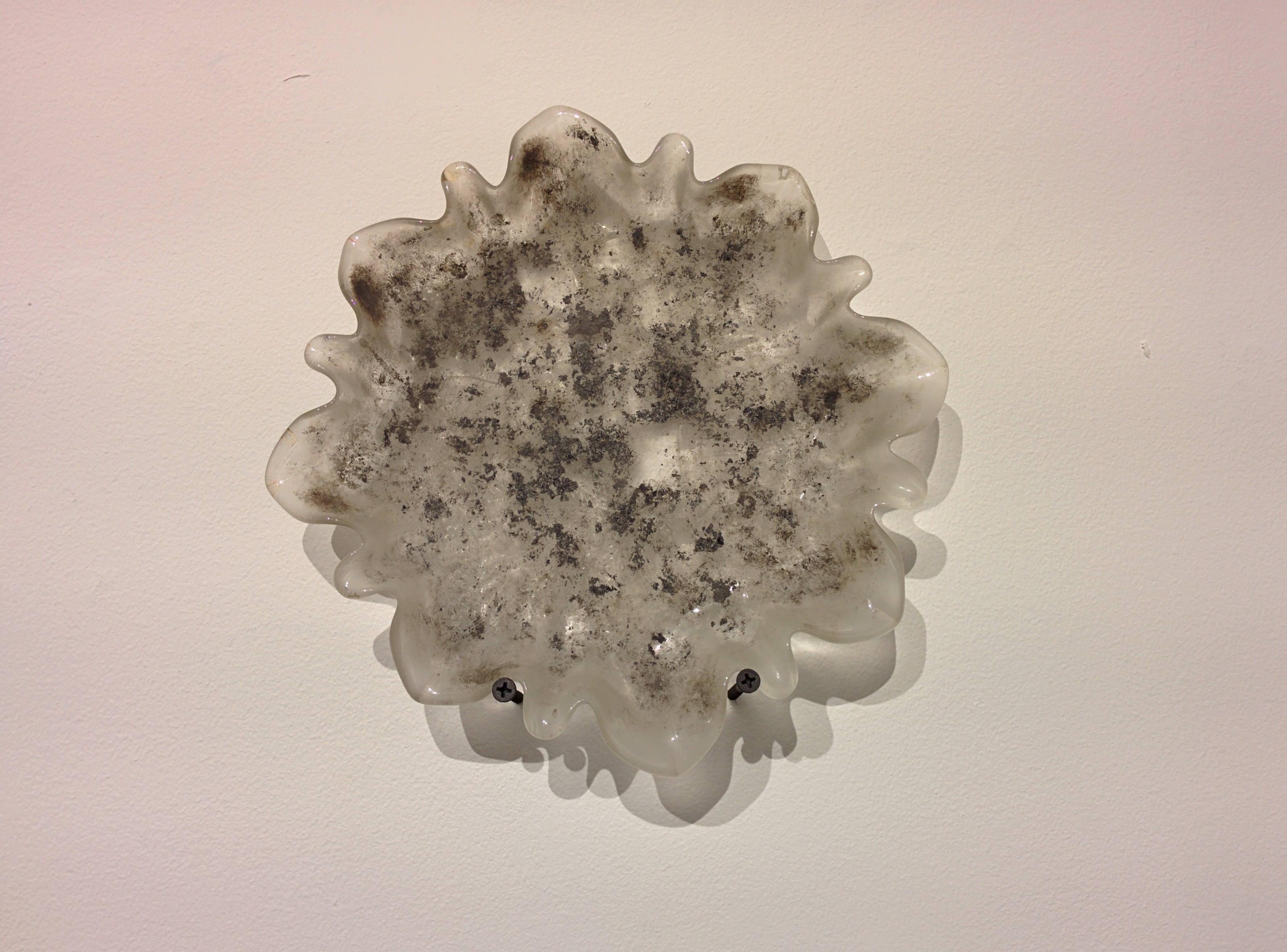
untitled, 2016. Glass, nails, ash. For Remains at Reed College Feldenheimer Gallery, with Erin Jane Nelson and fish narc
Finally, I’m just going to copy and paste an artist statement I wrote when I got asked to write about my practice’s relationship to “social justice,” because it feels like you’re coyly asking about politicization:
I am a poet and artist who is cruising dystopia. I work with found text, ephemeral sculpture, photography, and writing to ask the question: what does it mean for something to fail to be art, and how is value involved? My process is precarious; I use whatever is at hand in a given moment, operating on the basis of magical thinking. My work addresses language, the pretensions of the white Left, the relationship between debt and community, and the ritual aspects of aesthetics. I am less interested in an autonomous art practice or the creation of value, and more interested in working from the position of having been post-apocalyptic since 1492, to interrogate the trap of visibility and the conditions of affective and aesthetic legibility in a world where bodies of color like mine, trans or cis, have more value as a carcass-turned-hashtag than as a person. The deployment of failure in the neoliberal marriage of precarity and scarcity interests me on many fronts, partly due to my specific embodiment as a transgender nonbinary Dominican immigrant: failing to be a man or woman, failing to be Dominican or American, failing to be Black, white, latinx. Along with identity this extends to more general concerns about precarity: for example, the didactic role of documentation with respect to ephemeral art, or the precarity and unwaged nature of so much art labor as the art world and art education continues to professionalize. As well, my work and life would not be possible without the shelter of the vernacular, the hard love of family, the generative capacity of negativity, and the benevolence of my ancestors.
Questionnaire:
Age: 24
Location: Santo Domingo → Bronx → Portland, OR
How/when did you begin working creatively with technology?
.png)
In 5th grade, each classroom got an iMac and I remember loving to write bad short stories on the one in mine in a cursive font. This was also the year my northwest Bronx neighborhood became flooded with promotional AOL trial discs; some of the cases were wood, some plastic. I loved to empty the plastic ones, fill them with objects, and slip new covers into the laminate. I also used these cases to package and sell a rap album I made in 7th grade (I used to make beats with Anvil Studio, but switched to FL Studio). That same year, I remember being very active on a Magic: The Gathering forum, and creating cards and game mechanics with various other members.
While I definitely frequented AOL chatrooms, fan forums, and other contexts, what addicted me to digital sociality was the chatrooms in SoulSeek, a p2p file sharing program which differed from other programs I knew of in one crucial, almost erotic way: the ability to browse someone’s home computer file structure. This felt quite intimate. I feel like I’ve been chasing that sensation ever since, despite knowing now that the internet has become increasingly corporatized (and was back then, just less successfully).
Where did you go to school? What did you study?
I received my BA in Linguistics from Reed College in 2014. My thesis was on Spanish pronoun-like elements called clitics.
What do you do for a living or what occupations have you held previously?
I have worked as a transcriptionist, SEO copywriter, personal assistant, janitor, research assistant, small press managing editor, and babysitter. I currently work as an IT Compliance analyst and administrative assistant.
What does your desktop or workspace look like? (Pics or screenshots please!)
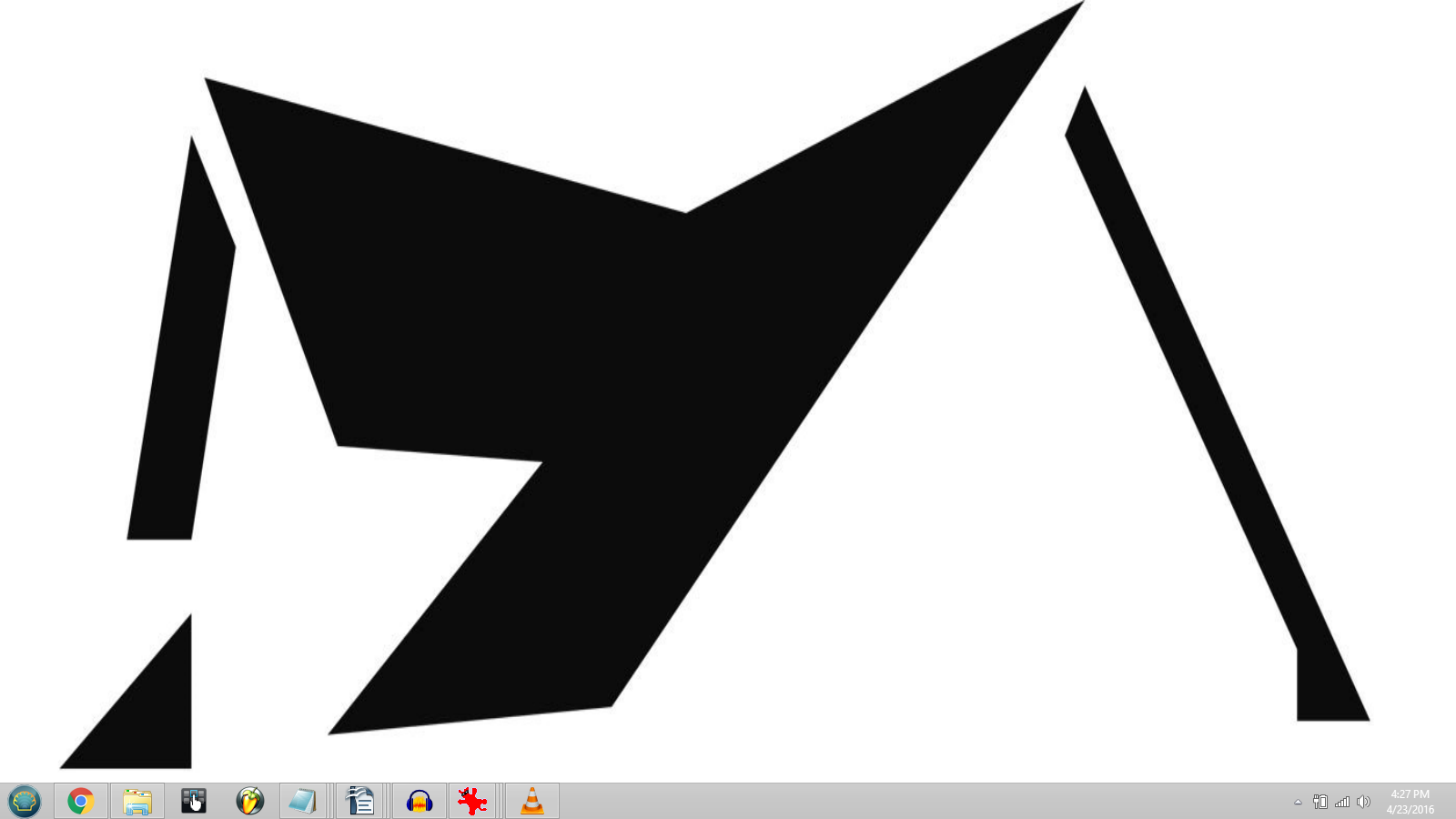
Top image: still from Servicio Digital a Papá Legba (2015)


